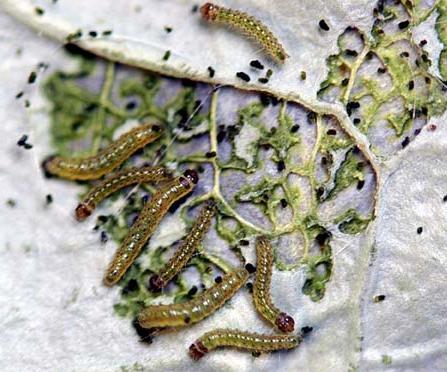Cabbage ( Brassica oleracea,
BRASSICACEAE ).
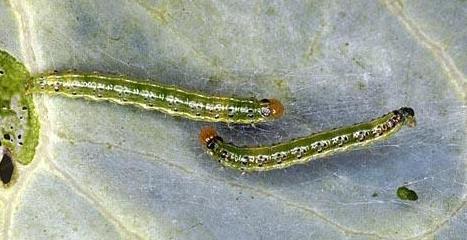
(Photo: copyright Lyn Finn,
Hunter Region School of Photography in Newcastle,
Macquarie Hills, New South Wales)
They are initially grey, and become green with a yellow
dorsal stripe.
They have a brown head.
Initially they feed only on the undersides of the leaves,
leaving the upper leaf membrane intact.
Later they attack the central shoot,
feeding communally in a web.
Over their larval period of about three weeks,
they grow to a length of about 2 cms.

(Photo: copyright Lyn Finn,
Hunter Region School of Photography in Newcastle,
Macquarie Hills, New South Wales)
The pupa is green turning brown with a length of about 1 cm.
It is formed in a loose cocoon in the loose soil at the base of the
foodplant.
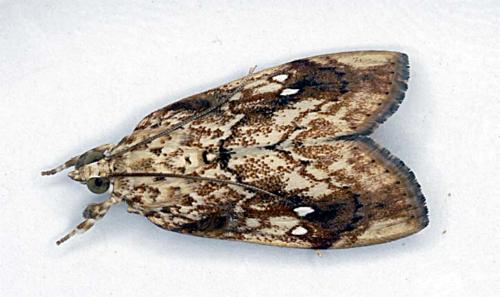
male
(Photo: copyright Lyn Finn,
Hunter Region School of Photography in Newcastle,
Macquarie Hills, New South Wales)
The adult moths are brown with dark markings,
and two white spots on each forewing.
The wingspan is about 3 cms.
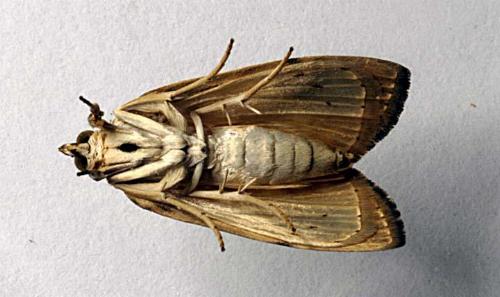
male, underside
(Photo: copyright Lyn Finn,
Hunter Region School of Photography in Newcastle,
Macquarie Hills, New South Wales)
The female is similar to the male but has a less
pronounced pattern on the wings.
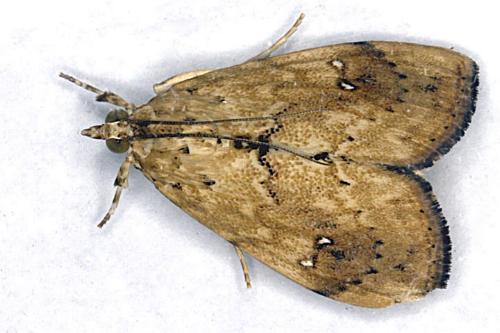
female
(Photo: copyright Lyn Finn,
Hunter Region School of Photography in Newcastle,
Macquarie Hills, New South Wales)
The eggs are somewhat flat, greenish and are laid in masses of up to 300 at a time.
They are arranged in scale-like fashion, one egg overlapping another.
They hatch after about four days.
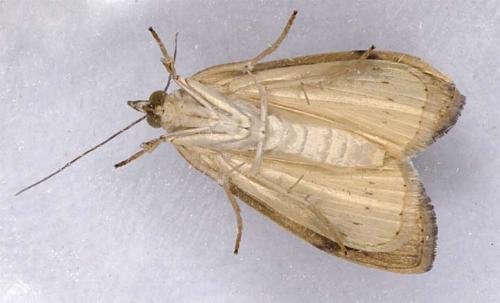
female, underside
(Photo: copyright Lyn Finn,
Hunter Region School of Photography in Newcastle,
Macquarie Hills, New South Wales)
The species is found from South Africa through India to the Pacific
including :
the spider
Oxyopes papuanus (
OXYOPIDAE ).
An interesting observation was made of some
moths that had emerged - all female.
They were found on their backs on the sand,
flapping their wings feebly.
Maybe if they get disorientated and overbalance when emerging,
before their wings dry and harden, they are not capable of turning
themselves over? After turning one the right way up, it got to its feet,
flapped its wings, and flipped straight over onto its
back again. If disorientation does cause their demise,
perhaps turning the soil around the base of their foodplant
when they are pupating would greatly cut down on next year's
infestation?
Further reading :
Ian F.B. Common,
Moths of Australia,
Melbourne University Press, 1990, fig. 33.13, p. 353.
Johan Christian Fabricius,
Entomologia systematica emendata et aucta,
Volume 3, Part 2 (1794), pp. 275-276, No. 142.
N. Othman,
Biology of Crocidolomia binotalis [Zeller] (Lepidoptera:
Pyralidae) and its Parasites from Cipanas Area (West Java),
PhD thesis (1982) BIOTROP, SEAMEO,
Regional Center for Tropical Biology, Bogor, Indonesia.
Buck Richardson,
Tropical Queensland Wildlife from Dusk to Dawn Science and Art,
LeapFrogOz, Kuranda, 2015, p. 29.
Paul Zborowski and Ted Edwards,
A Guide to Australian Moths,
CSIRO Publishing, 2007, p. 128.
(updated 3 November 2010, 16 December 2017)

